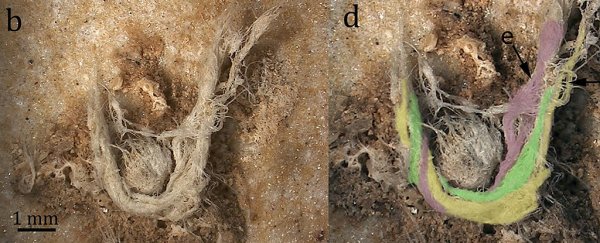Neanderthals were making string and cords from fibres long before early humans cottoned on to the technique, according to a new archaeological discovery.
Researchers have found a 6.2 millimetre (0.24 inch) fibre fragment which they date to around 41,000–52,000 years ago – so quite a bit older than the previous record holder, a 19,000-year-old fragment found in Israel.
The discovery was made in a cave in France, which would've been a Neanderthal settlement at the time. It suggests the species were smarter and more adept at crafts than we often give them credit for.
"Understanding and use of twisted fibres implies the use of complex multi-component technology as well as a mathematical understanding of pairs, sets, and numbers," write the researchers in their published paper.
"Added to recent evidence of birch bark tar, art, and shell beads, the idea that Neanderthals were cognitively inferior to modern humans is becoming increasingly untenable."
After discovering the fragment, the researchers used spectroscopy and microscopy techniques to analyse it and determine where the fibres had originally come from – probably the inner bark of a non-flowering tree, such as a conifer, before it hardened.
The team suggests that we have a poor understanding of the Neanderthals because perishable materials like this are usually long gone by the time we get to them. Tools and bones can only tell us so much.
If these ancient hominids were indeed able to make string, they would have had to know about the growth and seasonality of the trees the fibres were taken from, and been able to apply some numeracy skills to twist and bundle the fibres up into yarn.
In other words, making fibres and string is more complicated than you might realise. The researchers think the fragment they've discovered might have been a handle for the flint tool it was attached to, or part of a net or a bag for holding tools.
And this goes way beyond a bit of string. Once you can make a cord like this, it's not a huge leap to making fabric, baskets, mats and even boats. Again, the inference is that Neanderthals and their societies were more sophisticated than we give them credit for.
Some experts have urged caution about the findings, suggesting that the fibre may have been left behind by early humans – but this is far from the first study to produce evidence that Neanderthals were smarter than previously thought, nor is it the first study to propose that they could construct crafts in this way.
"The cognitive abilities for making string and rope are very similar to those for making language," anthropologist Bruce Hardy, from Kenyon College, told George Dvorsky at Gizmodo. "This speaks to the cognitive abilities of Neanderthals."
The research has been published in Scientific Reports.
